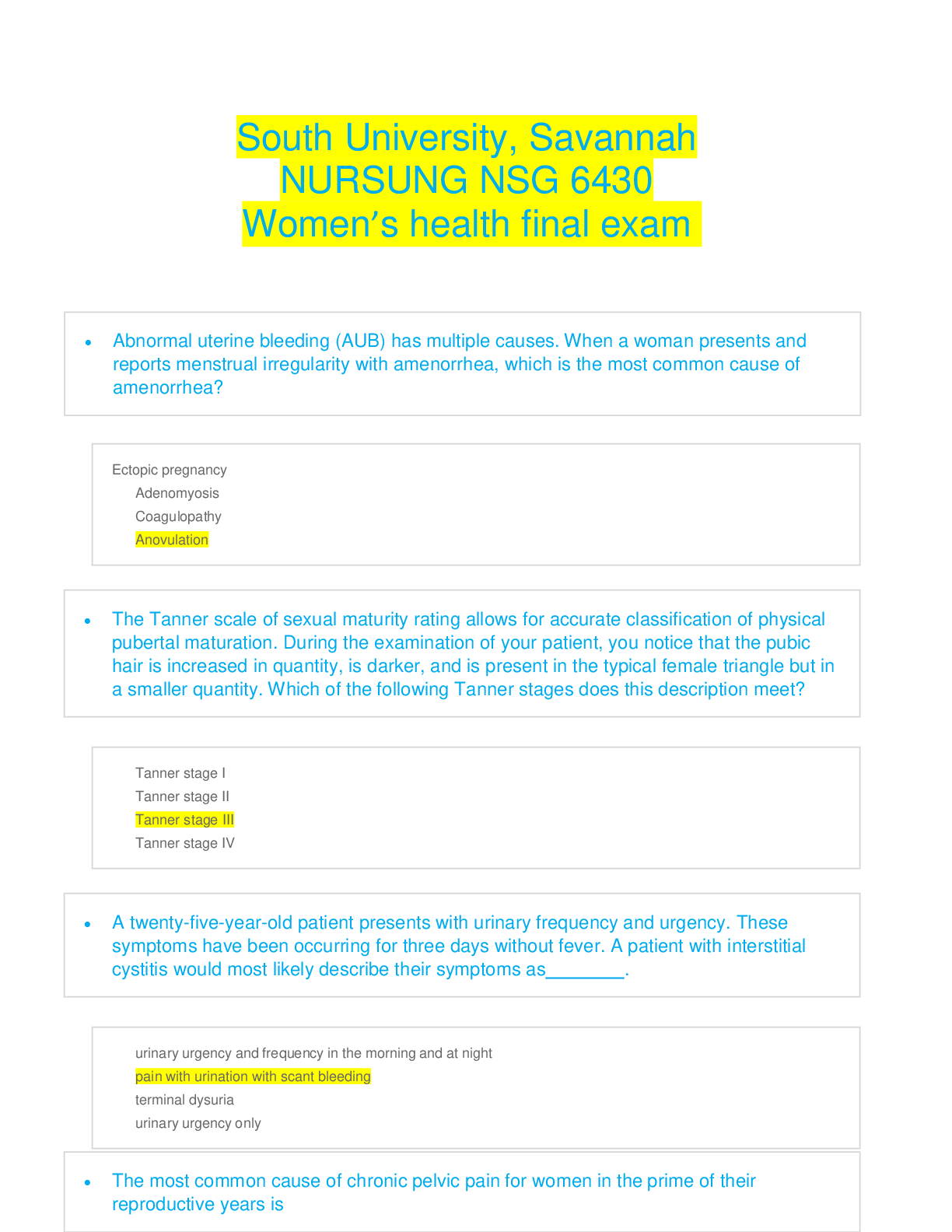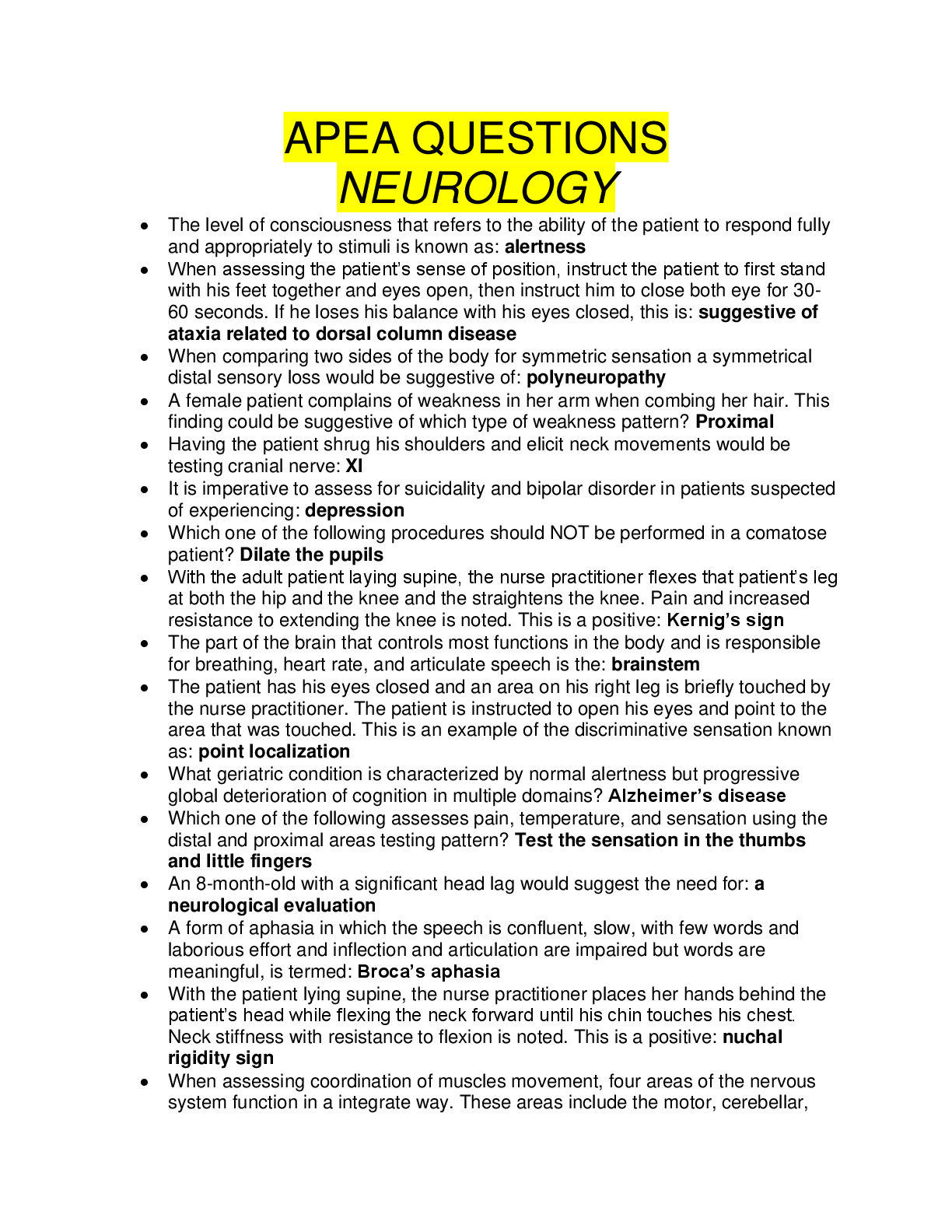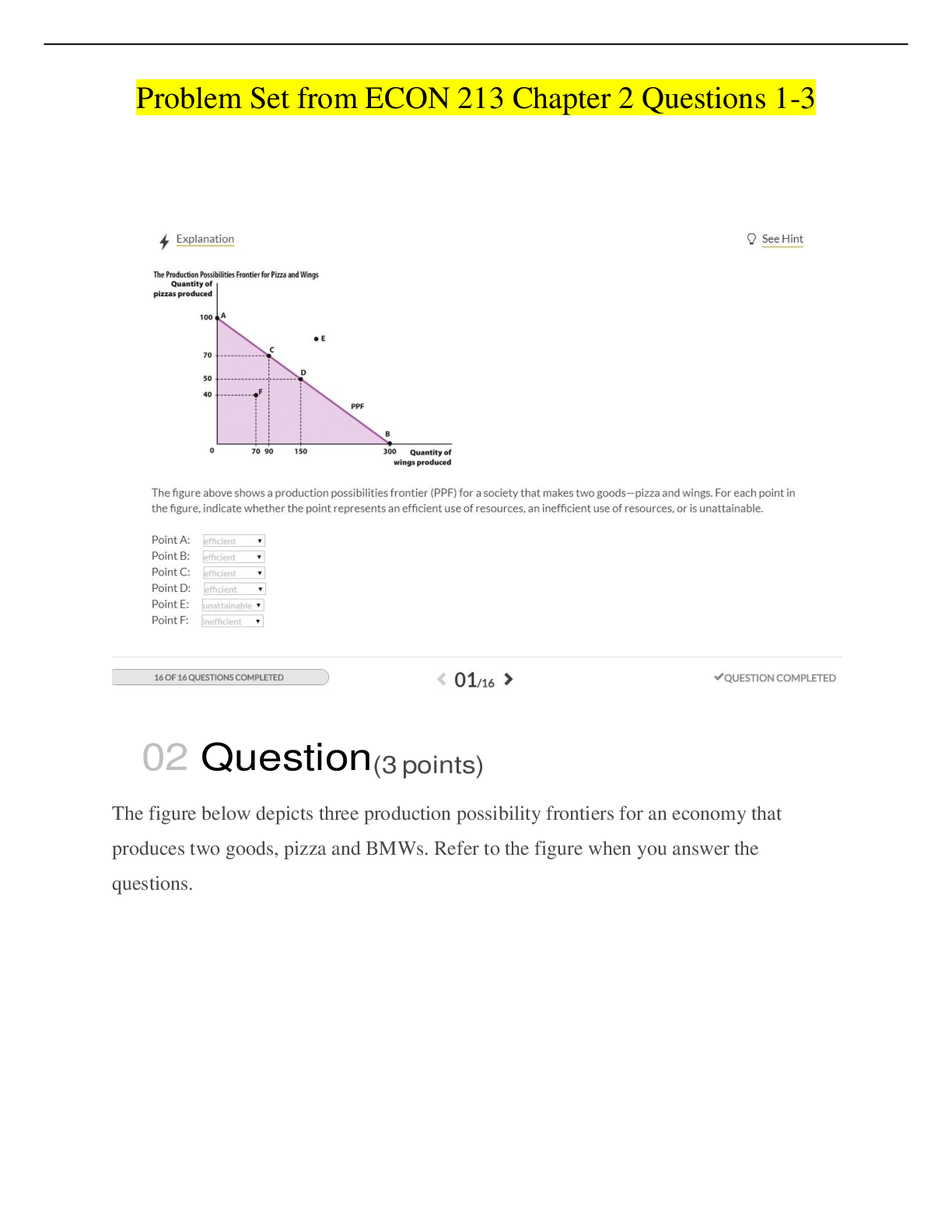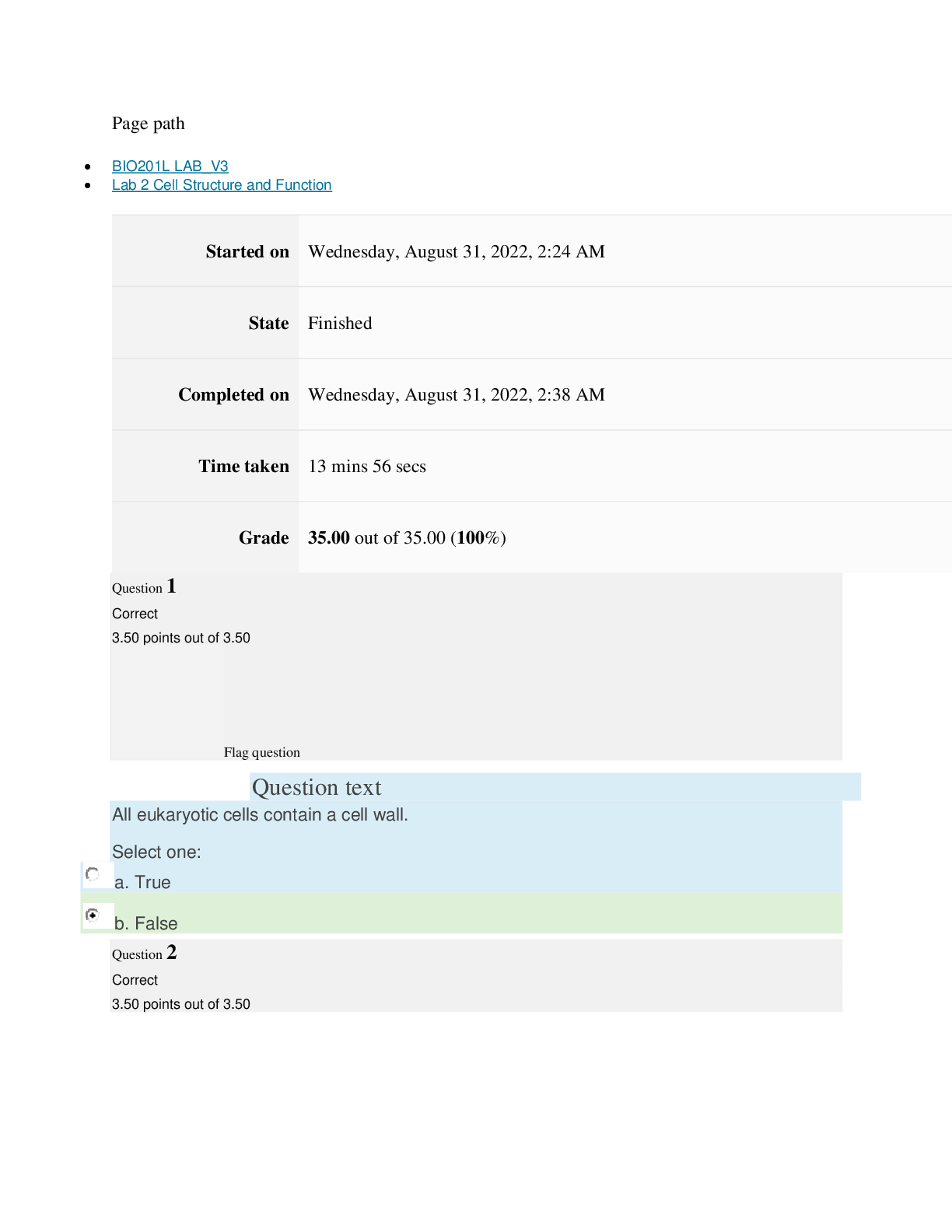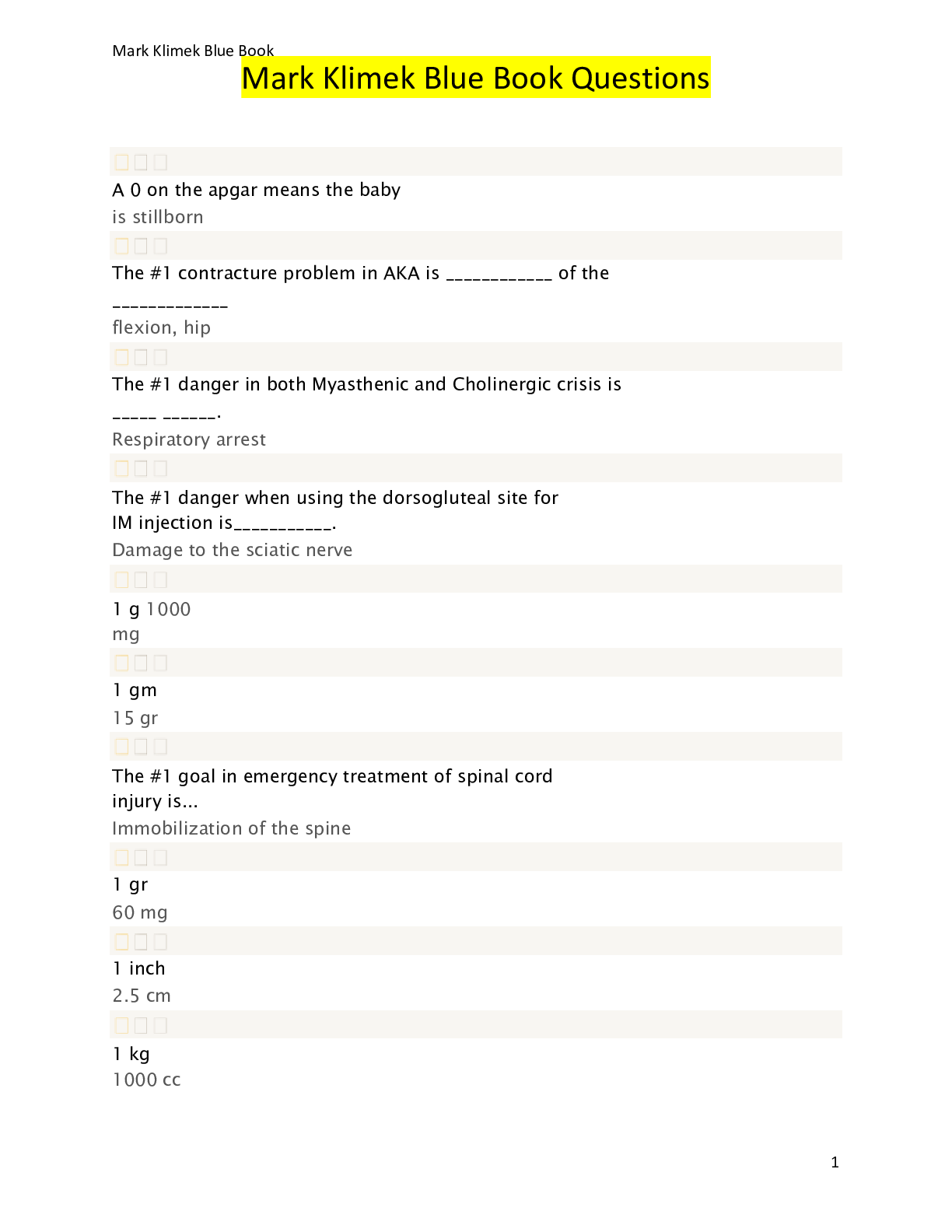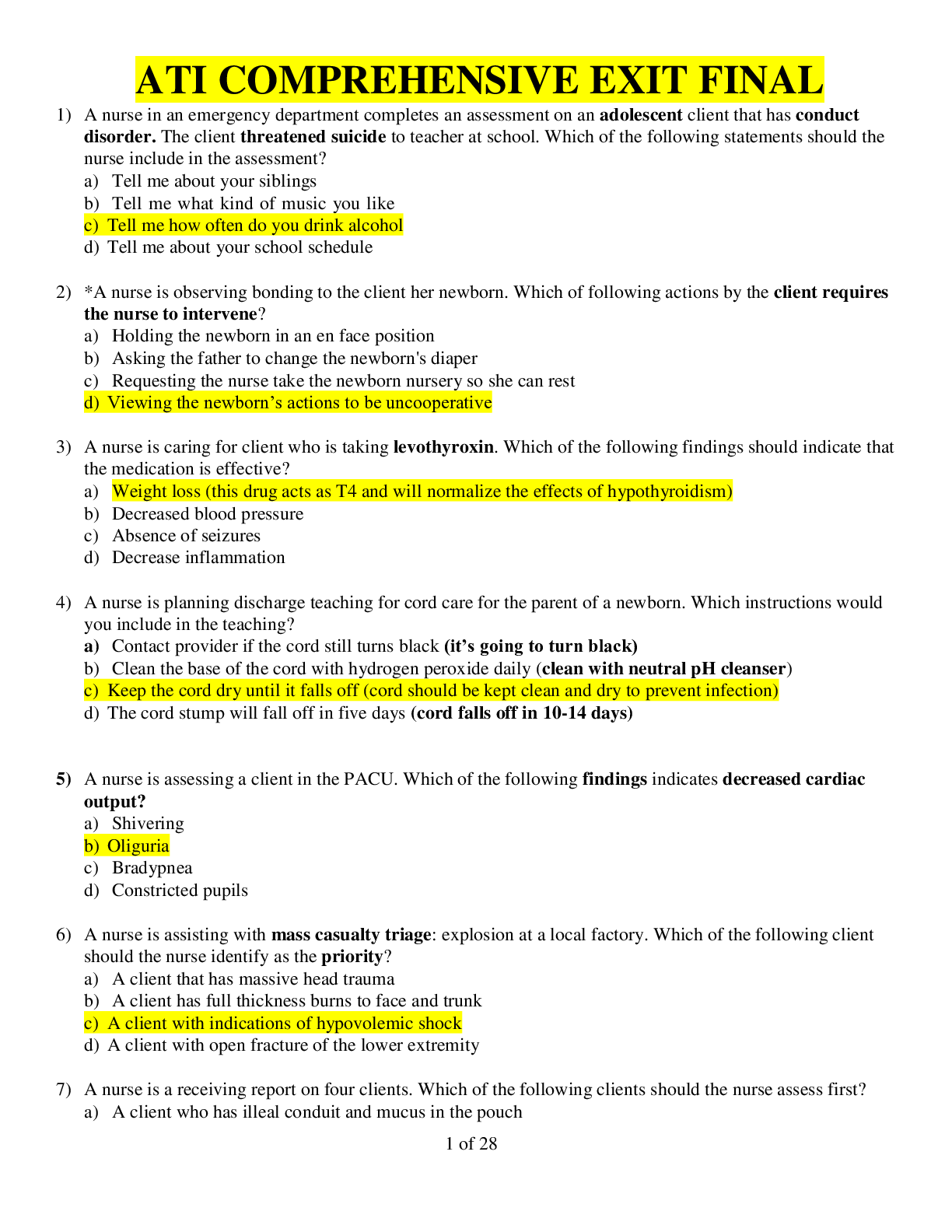*NURSING > QUESTIONS & ANSWERS > Safely Preparing and Giving Drugs Workman & LaCharity: (All)
Safely Preparing and Giving Drugs Workman & LaCharity:
Document Content and Description Below
Chapter 02: Safely Preparing and Giving Drugs Workman & LaCharity: Understanding Pharmacology: Essentials for Medication Safety, 2nd Edition MULTIPLE CHOICE BASIC CONCEPTS 1. How soon shoul... d a drug ordered as “STAT” be administered? a. Immediately b. With the next meal c. At the same time every day d. Only when the stomach is completely empty 2. When do most drug errors occur in a hospital setting? a. When a patient is in the emergency department b. When a patient is scheduled for a procedure c. When drugs are being administered to patients d. When two patients have the same last name 3. Which type of drug must always be swallowed without chewing? a. Liquid drugs b. Time-release drugs c. Drugs that taste bad d. Drugs that act on the intestinal tract 4. Which abbreviation means that a drug is to be given orally? a. PRN b. NPO c. PO d. PPD 5. Which needle position is best for an intradermal injection? a. Bevel side to the right b. Bevel side to the left c. Bevel side down d. Bevel side up 6. For which patient condition or problem are rectal drugs avoided? a. Fever b. Vomiting c. Diarrhea d. Pregnancy 7. Which injection site is located on the front of the thigh? a. Deltoid b. Dorsogluteal c. Ventrogluteal d. Vastus lateralis 8. What is the purpose of using the “Z-track” method of intramuscular injection? a. Preventing accidental intravenous injection b. Preventing oozing of drug back through the needle path c. Reducing the chances of hitting bone or nerve with the needle d. Allowing larger amounts (volumes) of drugs to be administered into smaller muscles 9. A patient needs a dose of oral potassium for a low serum potassium level (3.4 mEq/dL). Which type of order should the prescriber write? a. Standing order b. Single order c. PRN order d. STAT order 10. What temperature should ear drops be when applying them? a. Just above freezing −33 °F b. Warmed to 104 °F c. Refrigerated to 40 °F d. Room temperature DIF: Cognitive Level: Remembering REF: p. 40 11. What is the correct position for a sublingual tablet? a. As far back on the top of the tongue as possible without swallowing it b. Between the cheek and the gum of the upper teeth c. Between the cheek and the gum of the lower teeth d. Under the front of the tongue 12. When is it acceptable to take a verbal order from the prescriber before giving a drug to a patient? a. During the nightshift when the prescriber is not at the hospital b. In an emergency situation such as a cardiac arrest c. When a patient is experiencing severe pain d. At any time it is convenient 13. What is the most important role of the health care worker in preventing drug errors? a. Always checking the patient’s diagnosis before giving a drug b. Always following the “eight rights” of drug administration c. Being the one defense for detecting and preventing drug errors d. Being most likely to detect a drug error that has occurred 14. Which statement accurately describes the correct technique for giving subcutaneous drugs? a. Use a 3/4-inch, 25-gauge needle and a 15-degree angle for injection. b. Use a 3/8-inch, 25-gauge needle and a 45-degree angle for injection. c. Use a 1-inch, 22-gauge needle and a 90-degree angle for injection. d. Use a 2 inch, 25-gauge needle and a 45-degree angle for injection. 15. What administration technique should you use when giving a 2-year-old child ear drops? a. Pull the earlobe down and back. b. Pull the earlobe up and out. c. Keep the earlobe straight. d. Hang the patient’s head over the side of the bed. 16. What must you have a patient do after a vaginal drug is administered? a. Replace the drug in the refrigerator when not in use. b. Give the drug while the patient is sitting on the toilet. c. Have the patient empty her bladder after receiving this drug. d. Keep the patient lying down for 10 to 15 minutes after receiving the drug. 17. When giving a drug to a patient who is awake but confused, what is the best way to identify that it is the right patient? a. Check the room and bed number that the patient occupies. b. Ask the patient to state his or her name and birth date. c. Check the name on the patient’s wristband. d. Ask the patient if he or she is Mr. or Ms. [name]. 18. What is the best way to make sure that the right patient is receiving a prescribed drug when the patient is alert and oriented? a. Ask the patient to state his or her social security number. b. Check the patient’s wrist band. c. Look at the patient’s chart. d. Have the patient state his or her name and birth date. 19. Why are nose drops or sprays most often given? a. To treat dryness that may lead to nose bleeds. b. For allergies to pets, pollen, and molds. c. To treat congestion and infection. d. For cold and flu symptoms. ADVANCED CONCEPTS 20. Which technique is used with some intramuscular drug injections but not with subcutaneous or intradermal drug injections? a. Ensuring the site selected is appropriate for injection b. Cleansing the selected site before inserting the needle c. Aspirating the syringe before injecting the drug solution d. Checking for allergic or sensitivity reactions to the injection 21. What is the proper way to prepare skin for a transdermal patch? a. Shave the skin that will be underneath the patch. b. Leave the old patch on and apply the new one next to it. c. Clean and dry the skin where the patch will be applied. d. Remove the old patch and apply the new one to the exact same spot. 22. A patient is to receive nitroglycerin ointment, 1 inch STAT, for elevated blood pressure. What must be done before giving this drug? a. Shave the hair off the patient’s chest. b. Place the patient on a heart monitor. c. Put on a pair of disposable gloves. d. Measure the dose directly on the patient’s skin. 23. To prevent a drug overdose from receiving two doses too close together, what should you do immediately after giving a PRN pain drug? a. Ask if the patient’s pain has been relieved. b. Check the patient’s vital signs. c. Notify the prescriber. d. Document the action. 24. The prescriber orders atenolol (Tenormin) 25 mg to be given orally once a day to control a patient’s high blood pressure. You check the patient’s vital signs and find that the blood pressure is 128/80 mm Hg and the heart rate is 60 beats/min. What should you do first before giving this drug? a. Check the order for prescriber limitations on when the drug should be given. b. Notify the prescriber and ask if the drug should be given. c. Reassess the blood pressure and heart rate in 30 minutes. d. Give the drug exactly as prescribed. 25. A patient is prescribed omeprazole (Prilosec) 60 mg once a day orally. The patient is having difficulty with swallowing and has a feeding tube in place. What is your best action? a. Open the capsule and mix the contents with water, then give the drug through the feeding tube. b. Raise the head of the bed 90 degrees and mix the capsule in applesauce for easier swallowing. c. Contact the prescriber and pharmacist about using another drug or another form of the drug. d. Hold the tube feeding for at least 30 minutes before giving the drug. 26. A patient with severe postoperative pain is ordered to receive morphine 2 mg intravenously. The patient asks if the drug could be taken by mouth instead. What is your best response? a. “Giving the drug intravenously will give you faster pain relief.” b. “I will call your prescriber and ask if the order can be changed.” c. “Your surgeon wants you to receive the drug intravenously.” d. “We can substitute the intravenous drug with an oral drug.” 27. The prescriber orders a new drug over the telephone for a nursing home patient who has symptoms of a urinary tract infection. The order is for Gantanol, 2 g now and then 1 g every 12 hours for the next 10 days. What further information is most important for you to obtain from the prescriber? a. “How many refills are needed?” b. “Do you want the drug given orally or intravenously?” c. “Which brand of drug should be given, or is this a generic drug?” d. “Does this drug need to be given with a meal or on an empty stomach?” 28. The prescriber orders all of the following drugs for a patient who had surgery 2 days ago. Which drug order should you administer first? a. Alphamine (cyanocobalamin) 100 mcg intramuscularly once b. Benadryl (diphenhydramine) 25 mg orally every 8 hours c. Compazine (prochlorperazine) 10 mg orally STAT d. Dalmane (flurazepam) 30 mg orally at night PRN 29. You ask the patient to state his name and birth date, and the patient responds correctly. Then you give the patient the prescribed drug tablet. The patient says “I haven’t ever taken a green pill before.” What is your best response? a. “Go ahead and take the drug. The same medications from different drug companies may have a different color.” b. “Go ahead and take the drug. It is likely that your health care provider has prescribed a new drug for you.” c. “Don’t take this drug right now. It is probably not the one prescribed for you.” d. “Don’t take this drug right now. Let me recheck everything to be sure.” 30. Which question is most important for you to ask a patient before administering a new drug? a. “Are you allergic to any drugs?” b. “Do you know what this drug is for?” c. “When was the last time you ate or drank?” d. “What other drugs have you taken in the last 24 hours?” 31. When you bring in the next dose of a drug that a patient first received 6 hours ago, the patient reports a “pounding” heart rate ever since taking the last dose. What is your best first action? a. Document the report as the only action. b. Check the patient’s vital signs for changes. c. Hold the dose and notify the prescriber immediately. d. Reassure the patient that this is an expected response to the drug. 32. A 1-year-old child is prescribed a transdermal drug patch for pain control. To which site should you apply the patch? a. On the lower arm where changing the patch is easier b. On the back between the shoulders so the child cannot reach it c. On the upper chest so that any skin irritation can be seen quickly d. On the leg between the knee and the thigh for fastest drug absorption 33. Which action is most important when you prepare to administer an oral drug to a patient of any age? a. Asking the patient whether he or she prefers a tablet or a capsule b. Determining when the patient last ate or drank c. Assessing whether the patient has nausea d. Checking the patient’s ability to swallow 34. Which condition requires that you withhold a drug dose for a patient with a feeding tube? a. The drug is in the form of a tablet. b. The drug volume is greater than 20 mL. c. Carbon dioxide is detected from the feeding tube. d. The patient is unconscious and unable to swallow. 35. You prepare to administer an intravenous (IV) push drug, but the skin around the patient’s IV site is swollen and red. The patient states that the area hurts, and no blood return is obtained when you aspirate the IV setup. What is your best action? a. Continue IV administration of the drug. b. Discontinue IV administration and notify the prescriber. c. Dilute the drug more before injecting it into the current IV site. d. Reassure the patient that this is an expected reaction and offer the prescribed pain medication. 36. You are receiving a telephone order from a health care provider. After receiving all the information, what is the most important next action to perform? a. Notify the supervisor about the verbal order. b. Administer the drug as soon as it is available. c. Read the order back to the prescriber and ask whether it is correct. d. Inform the patient and family that a new drug has been prescribed by the health care provider. 37. What is the most important action to take after giving a patient a newly prescribed drug for hypertension? a. Teach the patient to measure his or her pulse. b. Check the patient’s blood pressure an hour later. c. Ask the patient whether any other family members also have hypertension. d. Ask the patient whether he or she has ever taken a drug for hypertension in the past. 38. When you bring a sedative for sleep in to the patient, he asks you to leave the drug on his table and he will take it when his television show is over. What should you do? a. Insist that he take the drug right now. b. Leave it at his bedside as he requests. c. Tell him you will bring it back later, after the show. d. Document that he refused to take his prescribed drug. MULTIPLE RESPONSE ADVANCED CONCEPTS 1. Before administering any drug, what should you do? (select all that apply) a. Check the order. b. Wash your hands. c. Instruct the patient that he or she must take the drug. d. Find out the patient’s family history. e. Check the patient’s identification band. f. Keep drug in container until at the bedside. 2. The patient with an NG tube has orders for several enteral drugs (e.g., capsules, tablets, and liquids). What should you do before giving these drugs? (select all that apply) a. Check with the pharmacist about crushing the tablets. b. Follow the procedures of the “eight rights.” c. Aspirate to check for stomach contents. d. Open the extended-release capsules. e. Inject 150 mL of water to check tube patency. f. Place the patient in a supine position. 3. You are teaching a patient about a prescribed sublingual drug. What will you be sure to tell the patient? (select all that apply) a. “Keep the drug sterile to avoid infection.” b. “Do not drink anything until the drug is completely dissolved.” c. “Place this drug between your jaw and your molar teeth.” d. “Notify your prescriber if you experience side effects.” e. “Place the drug beside or below the tongue.” f. “Don’t swallow this drug.” 4. You are giving morning medications to a patient who refuses to take an oral dose of docusate (Colace). What is your best response? a. “Your prescriber ordered that you must take this drug twice a day.” b. “Docusate will soften your bowel movements so that you do not strain.” c. “This drug will help prevent constipation while you are on bed rest.” d. “Can you tell me why you do not want to take the docusate?” 5. Safe drug administration requires that the individual giving a drug be knowledgeable about which drug features? (select all that apply) a. Purpose b. Actions c. Brand name d. Side effects e. Abnormal reactions f. Follow-up care 6. A patient is to receive an acetaminophen (Tylenol) suppository for an elevated temperature of 102.8° F. What actions must the nurse take? (select all that apply) a. Ask if the patient is having any diarrhea. b. Lubricate the blunt end of the suppository. c. Put on a pair of sterile gloves. d. Place the patient in the Sims’ position. e. Ask the patient to take a deep breath and bear down. f. Push the suppository into the rectum about 1 inch. 7. A patient with several chronic illnesses is being cared for in a hospital acute care setting. For which events should you expect to apply the principles of the process of medication reconciliation? (select all that apply) a. The patient is transferred from the ICU to a medical care unit. b. The patient is transported to radiology for a CT scan. c. The patient’s care is transferred from the evening to the night nurse. d. The patient is moved from an acute care to a long-term care facility. e. The patient is relocated to a private room on the same medical care unit. f. The patient is sent to a different hospital for specialized surgery. [Show More]
Last updated: 2 years ago
Preview 1 out of 17 pages
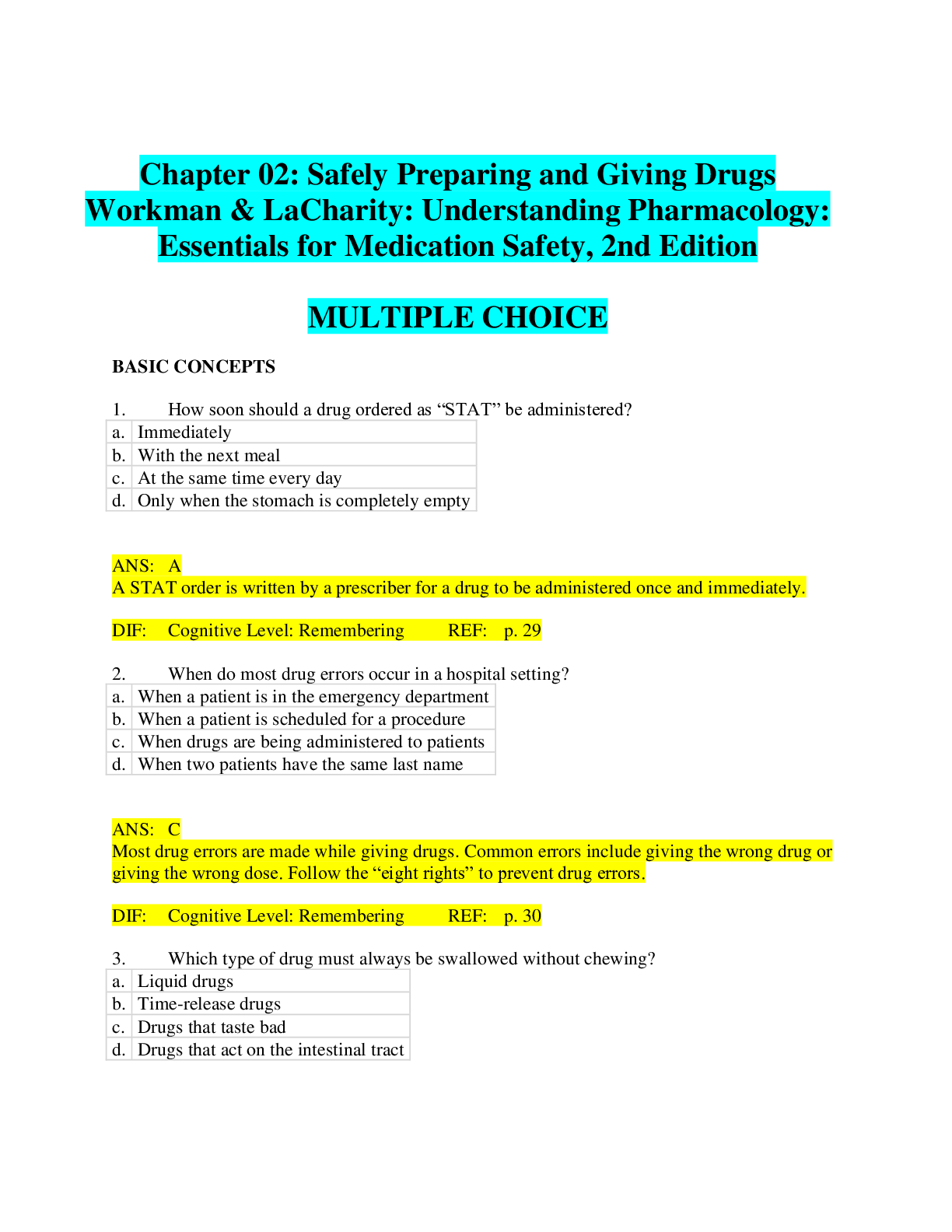
Buy this document to get the full access instantly
Instant Download Access after purchase
Buy NowInstant download
We Accept:

Reviews( 0 )
$7.00
Can't find what you want? Try our AI powered Search
Document information
Connected school, study & course
About the document
Uploaded On
Apr 14, 2020
Number of pages
17
Written in
Additional information
This document has been written for:
Uploaded
Apr 14, 2020
Downloads
0
Views
77

